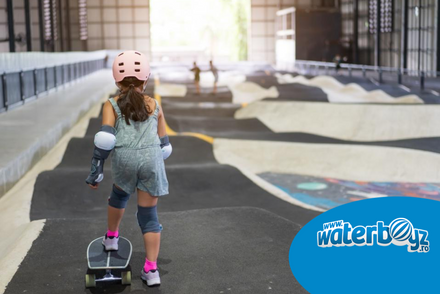Skateboarding is an activity with both health benefits and opportunities for building social relationships within the community of practitioners. Therefore, the number of enthusiasts forms a sample with significant growth potential. Typically, children and teenagers prefer this type of sport over other traditional physical activities due to various reasons, such as its dynamics, ease of learning, and easy access to specially designed skateparks, often located close to home.
Let's explore the impact of skateboarding within a community:
What does skateboarding involve?
Skateboarding involves using a specially designed board for this physical activity. The board is equipped with wheels (two in the front and two in the back) that allow movement on smooth surfaces. The board is set in motion by the propelling force of the skater.
Skateboards can be chosen based on experience or the type of skateboarding practiced. As a result, a variety of products are available on the market, ranging from classic-sized boards for skateparks or street skating to the popular longboards (the longest products in the range) and even options specifically designed for children (penny boards).
Regardless of the specific activity, wearing skateboarding protective gear is recommended to reduce the risk of injuries. This gear typically includes a protective helmet, knee pads, and elbow pads made from materials that absorb impact shocks and provide optimal support.
Who is this extreme sport dedicated to?
Skateboarding can be learned from the age of 4-5 years on straight surfaces with the support of a parent. It is essential for the learning process to take place in an open space so that the child is not inhibited by the presence of other skaters nearby.
As they approach adolescence and their development continues at a rapid pace, young skaters may transition from their first skateboards to ones that offer more comfort and mobility. Additionally, they may experience their first skatepark sessions, selecting areas with structural elements suitable for their limited experience:
- pumptracks - special circuits that allow beginners to skate at a comfortable pace on a specially designed surface with excellent grip and mobility.
- trix ramps - launch platforms with a low difference in height from the ground and a reduced slope, ideal for beginners getting familiar with skatepark elements.
A fully-equipped skatepark should also have areas with structural elements of higher difficulty levels, catering to teenagers or young adults with 8-10 years of skateboarding experience. Here are some examples:
- launch ramps - high-inclination launch platforms combined with other elements like pumptracks and flat banks.
- grind rails - steel bars of different sizes, designed for experienced skaters to slide along their surface. They can be installed directly on the ground or on inclined surfaces, next to stairs or on launching zones.
- half pipes - designed for freestyle competition or highly experienced skaters, these structures allow for creative execution of some of the most challenging tricks.
What are the benefits of skateboarding?
Like any other outdoor physical activity, skateboarding offers numerous benefits, which can be noticed from the very beginning of practice. Here are the most important ones:
- Stimulates various muscle groups: Skateboarding engages muscles in the back, legs, thighs, abdomen, and glutes. Muscle training is essential for correctly performing tricks in the skatepark and is also beneficial for daily activities such as pushing, pulling, and bending.
- Improves posture: Maintaining balance on a moving skateboard encourages skaters to keep their backs straight and shoulders raised. A correct posture involves keeping the spine aligned, avoiding pressure on the back area, and preventing associated pains.
- Enhances concentration: In a skatepark, skaters need to be highly attentive to their surroundings due to the activity of other skaters. This way, they can have fun with their friends without accidentally bumping into other practitioners or structural elements.
- Boosts metabolism: Calories obtained through food intake are transformed into energy necessary for skateboarding. Consequently, the risk of accumulating excess weight is significantly reduced. Additionally, the effort put into skateboarding contributes to burning fat, making it an essential cardio activity for overall health.
- Facilitates social integration: Based on this outdoor activity inside a playground area, young skaters can easily make friends with others of similar ages. Interpersonal relationships built around shared passions tend to be more stable, according to studies conducted on various population samples
- Increases self-confidence: Skateboarding enthusiasts usually have a very high self-esteem. This is because skateboarding is learned progressively with patience and practice, leading to significant rewards for the individual's mental well-being.
- Enhances the list of extracurricular activities: After school hours, children are often tempted to use mobile devices or gaming PCs. Skateboarding can keep them away from such sedentary activities, providing a healthy alternative.
What does setting up a skatepark in the community involve?
A skatepark represents a place for sports and socializing for the young generation, but the physical activities it offers can be tempting for other age groups as well. Therefore, such an outdoor space is ideal for the entire community, promoting a healthier lifestyle.
We have prepared a special article on setting up a skatepark to give you a clearer idea of the conception, development, and completion of such a complex project. For additional information, support during the planning phase, or clarification on other aspects, the Waterboyz team is always at your disposal.
We provide access to the most important resources for constructing such an outdoor space within your community, ensuring that your entire project has a well-defined consistency aligned with the objectives set with our support!
[email protected] | Call now: 0371 788 788




































































































































